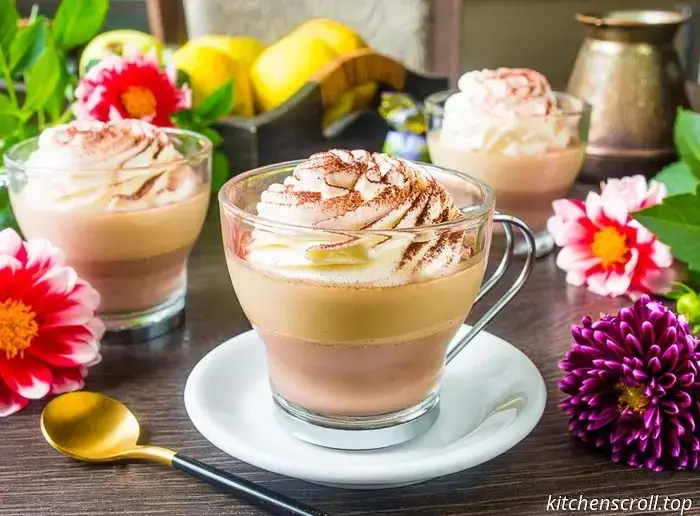
Beating cream is not a particularly complicated procedure. Nevertheless, it often raises questions I see in recipe comments. To put an end to this topic once and for all, I decided to write this post and provide a link to it in relevant recipes.
Let's figure out what’s what in this tricky world of heavy cream 🙂
WHAT TO WHIP?
We have cream with fat content ranging from 9% to 38% in stores. Not all of them are suitable for whipping.
Creams with 9% to 15% fat are considered drinking creams – added to coffee, beverages, cocktails, they are suitable for making cream jelly, custards.
Creams with 18% to 25% fat are mainly used for making sauces. They are thicker than drinking creams but are not suitable for whipping.
Creams with 30% to 38% fat are just what you need for whipping. They contain enough milk fat to create a stable mass. Moreover, such creams are necessary for making ganache.
WHAT TO WHIP WITH?
Sometimes I get messages like, "I whipped the cream with a blender for 10 minutes, but it didn’t whip at all. What am I doing wrong?"
Let me remember you once and for all: a blender is absolutely unsuitable for whipping cream (and egg whites). A mixer is required – either a hand immersion mixer or, when dealing with large volumes of cream, a stationary planetary mixer. At the very least, a whisk attachment for the immersion blender.
Some superhumans manage to whip cream manually with a whisk, but this is quite physically demanding. It’s better to have at least a modest mixer.
HOW TO WHIP?
The first and most important rule for successful whipping: THE CREAM MUST BE WELL CHILLED.
Chilling means not just half an hour or an hour in the fridge, but at least 4-5 hours. Better yet, leave the cream in the fridge overnight. And the larger the package, the longer it should be cooled.
To avoid ending up with the dessert already in progress but no cold cream for whipping, I now keep packs of cream bought in advance in the fridge—this is a real solution for scatterbrained people like me.
So, the cream whipping algorithm:
1. Chill the cream for at least 4-5 hours.
2. Take the pack out of the fridge and shake it well. During storage, the fatty cream separates into a thicker part and a more liquid part. Our task is to combine these parts and achieve a more or less uniform consistency.
3. Pour the cream into the container you plan to whip in. It should be dry and clean. Note: the same volume of cream whips faster in a narrow tall container than in a wide one. It makes sense to whip in a measuring glass rather than a bowl.
4. Whip the cream to soft or stiff peaks, depending on the purpose.
5. If you need to sweeten the cream, add powdered sugar about halfway through whipping. Sugar doesn’t always dissolve well.
WHY DO CREAMS WEAR OUT OR SEPARATE?
There can be several quite obvious reasons:
- The cream is poorly cooled or not cooled at all.
- The cream was whipped for too long.
- The cream was cooled but was whipped in a very hot room. This often happens when whipping small amounts of cream during summer heat.
HOW TO STABILIZE CREAM?
With gelatin:
- Use a ratio of 1 to 100 – that is, 1 gram of gelatin per 100 ml of cream.
- Soak the gelatin in water at a ratio of 1 to 6 (1 g gelatin to 6 ml water) and let it swell.
- Melt on the stove or in the microwave.
- Cool to room temperature.
- Start whipping the cream. As soon as it begins to thicken, slowly pour in the melted cooled gelatin in a thin stream, continuing to whip.
With cornstarch:
- For 250 ml of cream, use 1 teaspoon of cornstarch.
- Mix a quarter of the cream volume with cornstarch and powdered sugar.
- Put on the stove and, over medium heat, stir constantly until thickened.
- Remove, transfer to a clean container, and cool to room temperature.
- Whip the remaining cream to soft peaks (the mixer whisks leave confident streaks, but the mass is still soft and falls from a spoon). Add the starch mixture and whip everything together to stiff peaks.
Using special thickeners:
- Nowadays, various thickeners or stabilizers are available for sale. Most work on modified cornstarch. This stabilizer doesn’t need to be pre-diluted or prepared – it’s added directly to the cream while whipping. The required dosage is indicated on the packaging and may vary from manufacturer to manufacturer.


Whipping cream is not a particularly complicated procedure. Nevertheless, it often raises questions that I am asked in the comments on recipes. To put this topic to rest once and for all, I decided to write this post and include a link to it in the relevant recipes. Let's figure out what's what in this tricky...